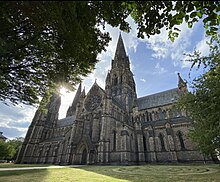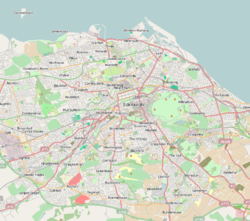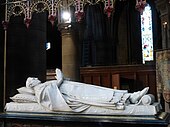
Sir George Gilbert Scott, largely known as Sir Gilbert Scott, was a prolific English Gothic Revival architect, chiefly associated with the design, building and renovation of churches and cathedrals, although he started his career as a leading designer of workhouses. Over 800 buildings were designed or altered by him.

The Cathedral of the Blessed Virgin Mary is a Church of England cathedral in the city of Truro, Cornwall. It was built between 1880 and 1910 to a Gothic Revival design by John Loughborough Pearson on the site of the parish church of St Mary. It is one of only three cathedrals in the United Kingdom featuring three spires.
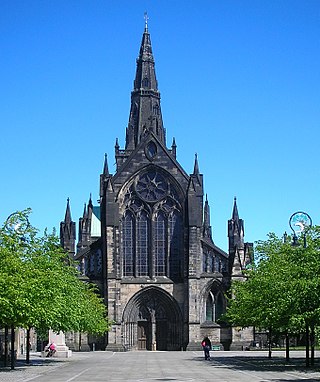
Glasgow Cathedral is a parish church of the Church of Scotland in Glasgow, Scotland. It is the oldest cathedral in mainland Scotland and the oldest building in Glasgow. The cathedral was the seat of the Archbishop of Glasgow, and the mother church of the Archdiocese of Glasgow and the Province of Glasgow, until the Scottish Reformation in the 16th century. Glasgow Cathedral and St Magnus Cathedral in Orkney are the only medieval cathedrals in Scotland to have survived the Reformation virtually intact. The medieval Bishop's Castle stood to the west of the cathedral until 1789. Although notionally it lies within the Townhead area of the city, the Cathedral grounds and the neighboring Necropolis are considered to be their own district within the city.
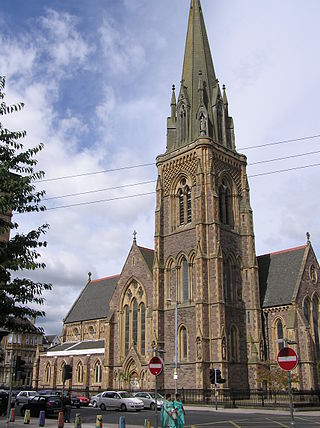
The Cathedral Church of St Mary the Virgin, commonly called St Mary's Cathedral, is a cathedral of the Scottish Episcopal Church. It is located on the Great Western Road, in the west end of Glasgow, Scotland. The current building was opened on 9 November 1871 as St Mary's Episcopal Church and was completed in 1893 when the spire was completed. The architect was Sir Gilbert Scott. It was raised to cathedral status in 1908. The total height of the cathedral is 63 metres. The church structure is protected as a category A listed building.
The Bishop of Edinburgh, or sometimes the Lord Bishop of Edinburgh, is the ordinary of the Scottish Episcopal Diocese of Edinburgh.

The Diocese of Dunkeld was one of the 13 historical dioceses of Scotland preceding the abolition of Episcopacy in 1689.

The Diocese of Edinburgh is one of the seven dioceses of the Scottish Episcopal Church. It covers the City of Edinburgh, the Lothians, the Borders and Falkirk. The diocesan centre is St Mary's Cathedral, Edinburgh. The Bishop of Edinburgh is the Right Revd Dr John Armes.

St Andrew's Cathedral, or the Cathedral Church of Saint Andrew, is a cathedral of the Scottish Episcopal Church situated in the Scottish city of Aberdeen. It is the see of the Bishop of Aberdeen and Orkney, who is the Ordinary of the Diocese of Aberdeen and Orkney.
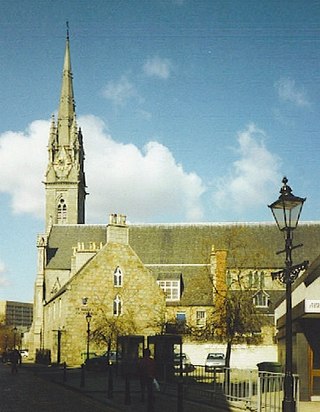
The Cathedral Church of St Mary of the Assumption, usually known as St Mary's Cathedral, is a cathedral of the Roman Catholic Church in the city of Aberdeen, Scotland. It is the home of the see of the Bishop of Aberdeen, who is the ordinary of the Diocese of Aberdeen in the Province of St Andrews & Edinburgh. It stands at 20 Huntly Street in Aberdeen.
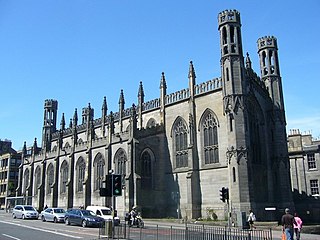
St Paul's and St George's Church is an evangelical church of the Scottish Episcopal Church in central Edinburgh, Scotland. It is located on the corner of Broughton Street and York Place in the east end of Edinburgh's New Town, and is protected as a category A listed building.

The Cathedral of the Isles and Collegiate Church of the Holy Spirit is a Category A listed cathedral of the Scottish Episcopal Church in the town of Millport on the Isle of Cumbrae. It is one of the two cathedrals of the Diocese of Argyll and the Isles, the other being St John's Cathedral in Oban. From 2021 the office of Provost has been held by Keith Riglin, Bishop of Argyll and The Isles.
Alexander Rose (1647–1720) was a Scottish scholar, minister and bishop. He was a Church of Scotland minister before becoming Professor of Divinity at the University of Glasgow and Principal of St Mary's College, St Andrews. He rose to become Bishop of Moray and then Bishop of Edinburgh. His failure to convince King William III and II that the Scottish bishops could be trusted led to the abolition of Episcopacy in Scotland. Rose continued as a nonjuring bishop, eventually becoming leader of the informal and embryonic Scottish Episcopal Church.
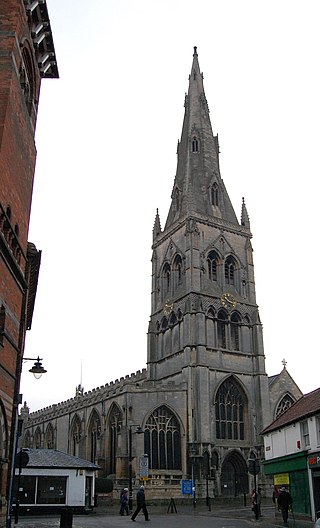
St Mary Magdalene Church, Newark-on-Trent is the parish church of Newark-on-Trent in Nottinghamshire, England. It is dedicated to Mary Magdalene and is the tallest structure in the town.

Wakefield Cathedral, or the Cathedral Church of All Saints in Wakefield, West Yorkshire, England, is a co-equal Anglican cathedral with Bradford and Ripon Cathedrals, in the Diocese of Leeds and a seat of the Bishop of Leeds. Originally the parish church, it has Anglo Saxon origins and, after enlargement and rebuilding, has the tallest spire in Yorkshire. Its 247-foot (75 m) spire is the tallest structure in the City of Wakefield. The cathedral was designated a Grade I listed building on 14 July 1953.
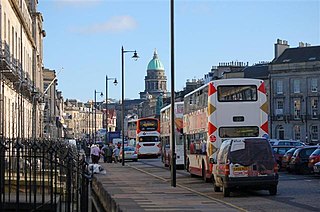
The West End is an affluent district of Edinburgh, Scotland, which along with the rest of the New Town and Old Town forms central Edinburgh, and Edinburgh's UNESCO World Heritage Site. The area boasts several of the city's hotels, restaurants, independent shops, offices and arts venues, including the Edinburgh Filmhouse, Edinburgh International Conference Centre and the Caledonian Hotel. The area also hosts art festivals and crafts fairs.
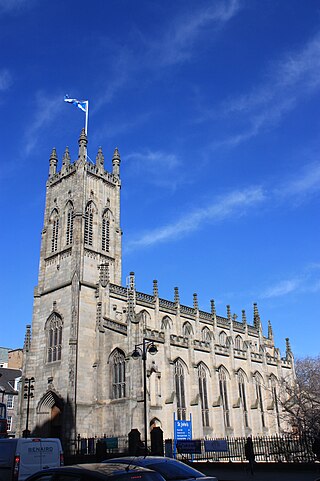
The Church of St John the Evangelist is a Scottish Episcopal church in the centre of Edinburgh, Scotland. It is sited at the west end of Princes Street at its junction with Lothian Road, and is protected as a category A listed building.

Christ Church, Southgate, is a Church of England parish church in Waterfall Road, Southgate, London. It describes itself as a "liberal catholic Church of England parish". The building is grade II* listed with Historic England. In 2014 the church registered as an Inclusive Church. The church choir makes regular recordings and tours as well as supporting worship on Sundays at 10am and at Choral Evensong at 6.30pm.

Alexander Ross FRIBA LLD was a 19th/20th century Scottish architect specialising in churches, especially for the Free Church of Scotland and the Scottish Episcopal Church. He was Provost of Inverness from 1889 to 1895.
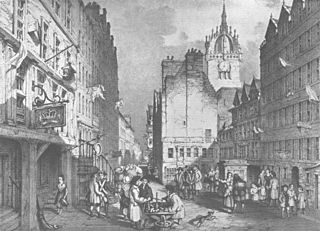
Sir John Byres of Coates (1569–1629) was a 16th/17th century Scottish banker and merchant who served as Treasurer and Old Provost for Edinburgh Town Council. Old Provost is the equivalent of Deputy Provost.
